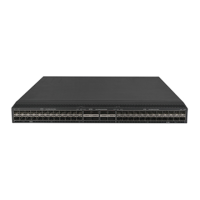32
Configuring the network diameter of a switched
network
About network diameter
Any two terminal devices in a switched network can reach each other through a specific path, and
there are a series of devices on the path. The switched network diameter is the maximum number of
devices on the path for an edge device to reach another one in the switched network through the root
bridge. The network diameter indicates the network size. The bigger the diameter, the larger the
network size.
Based on the network diameter you configured, the system automatically sets an optimal hello time,
forward delay, and max age for the device.
In STP, RSTP, or MSTP mode, each MST region is considered a device. The configured network
diameter takes effect only on the CIST (or the common root bridge) but not on other MSTIs.
In PVST mode, the configured network diameter takes effect only on the root bridges of the specified
VLANs.
Procedure
1. Enter system view.
system-view
2. Configure the network diameter of the switched network.
{ In STP/RSTP/MSTP mode:
stp bridge-diameter
diameter
{ In PVST mode:
stp vlan
vlan-id-list bridge-diameter diameter
The default setting is 7.
Setting spanning tree timers
About spanning tree timers
The following timers are used for spanning tree calculation:
• Forward delay—Delay time for port state transition. To prevent temporary loops on a network,
the spanning tree feature sets an intermediate port state (the learning state) before it transits
from the discarding state to the forwarding state. The feature also requires that the port transit
its state after a forward delay timer. This ensures that the state transition of the local port stays
synchronized with the peer.
• Hello time—Interval at which the device sends configuration BPDUs to detect link failures. If
the device does not receive configuration BPDUs within the timeout period, it recalculates the
spanning tree. The formula for calculating the timeout period is timeout period = timeout factor ×
3 × hello time.
• Max age—In the CIST of an MSTP network, the device uses the max age timer to determine
whether a configuration BPDU received by a port has expired. If it is expired, a new spanning
tree calculation process starts. The max age timer does not take effect on MSTIs.
To ensure a fast topology convergence, make sure the timer settings meet the following formulas:
• 2 × (forward delay – 1 second) ≥ max age
• Max age ≥ 2 × (hello time + 1 second)

